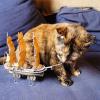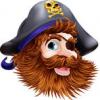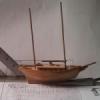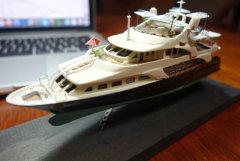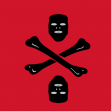MORE HANDBOOKS ARE ON THEIR WAY! We will let you know when they get here.
×
-
Posts
3,433 -
Joined
-
Last visited
Reputation Activity
-
 Cathead got a reaction from CaptainSteve in Pegasus 1776 by Chuck - 1:48 - Swan-class sloop cross-section
Cathead got a reaction from CaptainSteve in Pegasus 1776 by Chuck - 1:48 - Swan-class sloop cross-section
I dunno, Mark, buy a cheap tablet, prop it up, and set the display to rotate...
-
 Cathead got a reaction from popeye the sailor in Arabia 1856 by Cathead - FINISHED - Scale 1:64 - sidewheel riverboat from the Missouri River, USA
Cathead got a reaction from popeye the sailor in Arabia 1856 by Cathead - FINISHED - Scale 1:64 - sidewheel riverboat from the Missouri River, USA
Of course, Mike! You're already a steamboat veteran given your excellent Chaperon.
-
 Cathead reacted to Mike Dowling in Arabia 1856 by Cathead - FINISHED - Scale 1:64 - sidewheel riverboat from the Missouri River, USA
Cathead reacted to Mike Dowling in Arabia 1856 by Cathead - FINISHED - Scale 1:64 - sidewheel riverboat from the Missouri River, USA
I have only just found this Eric but I will follow along if it's OK.
-
 Cathead got a reaction from cog in The Tumblin' Dice by popeye the sailor - Artesania Latina - 1:80 - Mississippi riverboat
Cathead got a reaction from cog in The Tumblin' Dice by popeye the sailor - Artesania Latina - 1:80 - Mississippi riverboat
At the rate you people are starting build logs for this kit, I'm about ready to figure out how to design and offer another riverboat kit to give more options given the apparent interest.
-
 Cathead got a reaction from Omega1234 in The Tumblin' Dice by popeye the sailor - Artesania Latina - 1:80 - Mississippi riverboat
Cathead got a reaction from Omega1234 in The Tumblin' Dice by popeye the sailor - Artesania Latina - 1:80 - Mississippi riverboat
At the rate you people are starting build logs for this kit, I'm about ready to figure out how to design and offer another riverboat kit to give more options given the apparent interest.
-
 Cathead reacted to campbewj in Rattlesnake by campbewj - FINISHED - Model Shipways - American Privateer by Bill Campbell
Cathead reacted to campbewj in Rattlesnake by campbewj - FINISHED - Model Shipways - American Privateer by Bill Campbell
All, Continue to make progress on the Rattlesnake. I'm better about working on the model than posting pictures about the progress. A few weeks back I completed the planking around the gun ports to where the rails would be. I haven't done the rails yet. I've done preliminary sanding and like the way things have turned out. There will be more sanding and cleaning up the ports before I would call them done but I did enough to convince myself I wasn't digging myself into a big hole. There are 4 pictures of this part of the ship. I've now started the lowing planking as well and have found the larger wood strips more difficult to work with. I'm just taking it slow, bending the strips for the bow and the stern and taking my time. More pictures to come of that part of the ship. It's slow going so the posts don't come that often.
-
 Cathead got a reaction from mtaylor in The Tumblin' Dice by popeye the sailor - Artesania Latina - 1:80 - Mississippi riverboat
Cathead got a reaction from mtaylor in The Tumblin' Dice by popeye the sailor - Artesania Latina - 1:80 - Mississippi riverboat
At the rate you people are starting build logs for this kit, I'm about ready to figure out how to design and offer another riverboat kit to give more options given the apparent interest.
-
 Cathead got a reaction from popeye the sailor in Arabia 1856 by Cathead - FINISHED - Scale 1:64 - sidewheel riverboat from the Missouri River, USA
Cathead got a reaction from popeye the sailor in Arabia 1856 by Cathead - FINISHED - Scale 1:64 - sidewheel riverboat from the Missouri River, USA
Good question. Yes, sidewheelers generally had one center rudder, because their hulls were more ship-like (tapering at the stern) so water flowed properly past a single rudder; they were also more maneuverable due to the ability to back each engine separately. Sternwheelers commonly had two to four rudders, often linked into a single system. My understanding is that their more barge-like square sterns didn't funnel water past rudders as efficiently, so they needed more rudders spaced across the stern to compensate. For example, here are the rudders on my model of Bertrand:
These were built in two paired assemblies; the inner two were connected to the actual steering gear, and the outer two were slaved to their partners. Also note that each rudder fits into an extension that runs forward into the curve of the hull; my understanding is that this helped direct water properly onto each rudder. The hull was shaped this way on sternwheelers (wide and square like a barge rather than tapered like a ship) because that design provided the extra buoyancy needed to support the massive, heavy sternwheel.
In comparison, here is the salvaged stern of the Arabia:
Note how the hull naturally tapers to the single rudder, which it can do because the wheels and engines are placed much more forward on a sidewheeler, so the stern can be shaped "normally", allowing for more efficient water flow to the rudder.
If this still isn't clear, I can try to take comparative photos of the two models to better illustrate the difference.
-
 Cathead got a reaction from Azzoun in Pegasus 1776 by Chuck - 1:48 - Swan-class sloop cross-section
Cathead got a reaction from Azzoun in Pegasus 1776 by Chuck - 1:48 - Swan-class sloop cross-section
Yeah, I'm drooling. Thanks so much for taking the extra time to share this process with us. I'll certainly pay you back when this hits the market.
-
 Cathead got a reaction from popeye the sailor in Arabia 1856 by Cathead - FINISHED - Scale 1:64 - sidewheel riverboat from the Missouri River, USA
Cathead got a reaction from popeye the sailor in Arabia 1856 by Cathead - FINISHED - Scale 1:64 - sidewheel riverboat from the Missouri River, USA
Watching the winter Olympics has both slowed and helped my work. Slowed, because it's been an evening time sink watching so many events I enjoy. Helped, because I moved into the final parts of hull planking that required more careful shaping and manual gluing, so it gave me something to do while messing with individual planks.
I've been planking from the outside in, and once I got too near the centerline, my normal binder-clip clamps (black, below) wouldn't fit anymore. So I started using reversed and halved clothespins instead, whose angled shapes work quite well as wedges (also below). Their clamping parts aren't doing anything, but wedging them into the narrow gaps between plank and the center bulkhead worked really well, at least for straight areas. For curved areas, I mostly did this manually and watched Olympics. But I was really pleased with this method.
Then I made a frustrating mistake, managing to snap off a big chunk of the curve bow guard extension. It actually wasn't hard to repair, I just cut away most of the bow's curve on both sides, and bend and inserted a new piece that fully swept around that curve. It's not quite as nice as the original because the new joint was harder to hide, but when the model is finished it won't really show. I was still very annoyed with myself because I've been so careful in handling.
So here's the planked hull. Note that in this photo I've begun inserting the extra guard timbers at the stern, but not yet at the bow, to bring them up to the right density. If I had decided to plank over the underside of the guards, I wouldn't have needed to do this, so hadn't until the decision was made. But there's abundant evidence that leaving the guards open underneath is the right approach, so in go the rest of the guards.
As you may be able to tell above, I also used some wood filler to match a few less-than-ideal gaps in planking, mostly in the complicated stern area. Above, I've applied it to the starboard (lower) side but not yet the port (upper side), and haven't yet sanded it down. Below is a closer look at the stern, with one side filled and one side not. In this photo, it has been sanded. It's definitely smoother now but the planking lines still show through. I'm pleased with how this came out overall, though I did struggles to get the run of planking right and could probably have done it better. Those odd extensions at the very stern are on the real thing, I'll come back to that soon when I show the building of the rudder.
And here she is with all the guard timbers installed, right side up with my machinery templates laid out for reference. If you look closely at the starboard wheel area, you'll see a little vertical wooden thing that doesn't resolve well in the photo. That's my rough person for scale, he's about 5'8", shorter than me but about right for the period. The wheel is in about the right vertical place and orientation. The plain white rectangle represents the boilers.
So that's where Arabia stands post-Olympics. Next up, I need to cut way too many short strips of hull planking to fill in the last strake between all the guard timbers, then do any final hull finishing necessary. I'll paint the hull next before proceeding to planking the deck, and also will finish the rudder, though I probably won't install it until the very end to keep if from being knocked off. Then, finally, I'll move toward deck planking.
Thanks as always for following along. Hopefully this starts to get more interesting soon as we turn her right side up and the machinery and superstructure get underway.
-
 Cathead got a reaction from Canute in Pegasus 1776 by Chuck - 1:48 - Swan-class sloop cross-section
Cathead got a reaction from Canute in Pegasus 1776 by Chuck - 1:48 - Swan-class sloop cross-section
Yeah, I'm drooling. Thanks so much for taking the extra time to share this process with us. I'll certainly pay you back when this hits the market.
-
 Cathead got a reaction from CaptainSteve in Arabia 1856 by Cathead - FINISHED - Scale 1:64 - sidewheel riverboat from the Missouri River, USA
Cathead got a reaction from CaptainSteve in Arabia 1856 by Cathead - FINISHED - Scale 1:64 - sidewheel riverboat from the Missouri River, USA
Watching the winter Olympics has both slowed and helped my work. Slowed, because it's been an evening time sink watching so many events I enjoy. Helped, because I moved into the final parts of hull planking that required more careful shaping and manual gluing, so it gave me something to do while messing with individual planks.
I've been planking from the outside in, and once I got too near the centerline, my normal binder-clip clamps (black, below) wouldn't fit anymore. So I started using reversed and halved clothespins instead, whose angled shapes work quite well as wedges (also below). Their clamping parts aren't doing anything, but wedging them into the narrow gaps between plank and the center bulkhead worked really well, at least for straight areas. For curved areas, I mostly did this manually and watched Olympics. But I was really pleased with this method.
Then I made a frustrating mistake, managing to snap off a big chunk of the curve bow guard extension. It actually wasn't hard to repair, I just cut away most of the bow's curve on both sides, and bend and inserted a new piece that fully swept around that curve. It's not quite as nice as the original because the new joint was harder to hide, but when the model is finished it won't really show. I was still very annoyed with myself because I've been so careful in handling.
So here's the planked hull. Note that in this photo I've begun inserting the extra guard timbers at the stern, but not yet at the bow, to bring them up to the right density. If I had decided to plank over the underside of the guards, I wouldn't have needed to do this, so hadn't until the decision was made. But there's abundant evidence that leaving the guards open underneath is the right approach, so in go the rest of the guards.
As you may be able to tell above, I also used some wood filler to match a few less-than-ideal gaps in planking, mostly in the complicated stern area. Above, I've applied it to the starboard (lower) side but not yet the port (upper side), and haven't yet sanded it down. Below is a closer look at the stern, with one side filled and one side not. In this photo, it has been sanded. It's definitely smoother now but the planking lines still show through. I'm pleased with how this came out overall, though I did struggles to get the run of planking right and could probably have done it better. Those odd extensions at the very stern are on the real thing, I'll come back to that soon when I show the building of the rudder.
And here she is with all the guard timbers installed, right side up with my machinery templates laid out for reference. If you look closely at the starboard wheel area, you'll see a little vertical wooden thing that doesn't resolve well in the photo. That's my rough person for scale, he's about 5'8", shorter than me but about right for the period. The wheel is in about the right vertical place and orientation. The plain white rectangle represents the boilers.
So that's where Arabia stands post-Olympics. Next up, I need to cut way too many short strips of hull planking to fill in the last strake between all the guard timbers, then do any final hull finishing necessary. I'll paint the hull next before proceeding to planking the deck, and also will finish the rudder, though I probably won't install it until the very end to keep if from being knocked off. Then, finally, I'll move toward deck planking.
Thanks as always for following along. Hopefully this starts to get more interesting soon as we turn her right side up and the machinery and superstructure get underway.
-
 Cathead got a reaction from mmdd in Arabia 1856 by Cathead - FINISHED - Scale 1:64 - sidewheel riverboat from the Missouri River, USA
Cathead got a reaction from mmdd in Arabia 1856 by Cathead - FINISHED - Scale 1:64 - sidewheel riverboat from the Missouri River, USA
Good question. Yes, sidewheelers generally had one center rudder, because their hulls were more ship-like (tapering at the stern) so water flowed properly past a single rudder; they were also more maneuverable due to the ability to back each engine separately. Sternwheelers commonly had two to four rudders, often linked into a single system. My understanding is that their more barge-like square sterns didn't funnel water past rudders as efficiently, so they needed more rudders spaced across the stern to compensate. For example, here are the rudders on my model of Bertrand:
These were built in two paired assemblies; the inner two were connected to the actual steering gear, and the outer two were slaved to their partners. Also note that each rudder fits into an extension that runs forward into the curve of the hull; my understanding is that this helped direct water properly onto each rudder. The hull was shaped this way on sternwheelers (wide and square like a barge rather than tapered like a ship) because that design provided the extra buoyancy needed to support the massive, heavy sternwheel.
In comparison, here is the salvaged stern of the Arabia:
Note how the hull naturally tapers to the single rudder, which it can do because the wheels and engines are placed much more forward on a sidewheeler, so the stern can be shaped "normally", allowing for more efficient water flow to the rudder.
If this still isn't clear, I can try to take comparative photos of the two models to better illustrate the difference.
-
 Cathead got a reaction from popeye the sailor in Arabia 1856 by Cathead - FINISHED - Scale 1:64 - sidewheel riverboat from the Missouri River, USA
Cathead got a reaction from popeye the sailor in Arabia 1856 by Cathead - FINISHED - Scale 1:64 - sidewheel riverboat from the Missouri River, USA
To the best of my knowledge, hulls were always painted (usually white).
-
 Cathead got a reaction from CaptainSteve in Pegasus 1776 by Chuck - 1:48 - Swan-class sloop cross-section
Cathead got a reaction from CaptainSteve in Pegasus 1776 by Chuck - 1:48 - Swan-class sloop cross-section
Yeah, I'm drooling. Thanks so much for taking the extra time to share this process with us. I'll certainly pay you back when this hits the market.
-
 Cathead got a reaction from mtaylor in Pegasus 1776 by Chuck - 1:48 - Swan-class sloop cross-section
Cathead got a reaction from mtaylor in Pegasus 1776 by Chuck - 1:48 - Swan-class sloop cross-section
Yeah, I'm drooling. Thanks so much for taking the extra time to share this process with us. I'll certainly pay you back when this hits the market.
-
 Cathead got a reaction from hexnut in Arabia 1856 by Cathead - FINISHED - Scale 1:64 - sidewheel riverboat from the Missouri River, USA
Cathead got a reaction from hexnut in Arabia 1856 by Cathead - FINISHED - Scale 1:64 - sidewheel riverboat from the Missouri River, USA
Good question. Yes, sidewheelers generally had one center rudder, because their hulls were more ship-like (tapering at the stern) so water flowed properly past a single rudder; they were also more maneuverable due to the ability to back each engine separately. Sternwheelers commonly had two to four rudders, often linked into a single system. My understanding is that their more barge-like square sterns didn't funnel water past rudders as efficiently, so they needed more rudders spaced across the stern to compensate. For example, here are the rudders on my model of Bertrand:
These were built in two paired assemblies; the inner two were connected to the actual steering gear, and the outer two were slaved to their partners. Also note that each rudder fits into an extension that runs forward into the curve of the hull; my understanding is that this helped direct water properly onto each rudder. The hull was shaped this way on sternwheelers (wide and square like a barge rather than tapered like a ship) because that design provided the extra buoyancy needed to support the massive, heavy sternwheel.
In comparison, here is the salvaged stern of the Arabia:
Note how the hull naturally tapers to the single rudder, which it can do because the wheels and engines are placed much more forward on a sidewheeler, so the stern can be shaped "normally", allowing for more efficient water flow to the rudder.
If this still isn't clear, I can try to take comparative photos of the two models to better illustrate the difference.
-
 Cathead reacted to leclaire in Arabia 1856 by Cathead - FINISHED - Scale 1:64 - sidewheel riverboat from the Missouri River, USA
Cathead reacted to leclaire in Arabia 1856 by Cathead - FINISHED - Scale 1:64 - sidewheel riverboat from the Missouri River, USA
Thanks Eric, your explanation is very clear and makes a lot of sense. I had a hunch it had something to do with the shape of the stern and the subsequent flow of water around the hull but figured you were the guy to ask. I am surprised to see that some boats had up to four rudders but again your explanation makes it clear as to the reason.
Bob
-
 Cathead reacted to kurtvd19 in Building a kit for a profit
Cathead reacted to kurtvd19 in Building a kit for a profit
Somebody once said this about making money as a model builder "You can make a small fortune as a model builder. However, you must first start with a large fortune".
Whatever you charge make sure you have a contract and that you get a substantial deposit - a minimum of 1/3 of the final figure - before you start anything. The deposit has to cover all your expenses and some profit just in case the buyer drops dead or declares bankruptcy.
Kurt
-
 Cathead reacted to semorebutts in Bismarck by Semorebutts - FINISHED - Trumpeter - 1/200 scale - PLASTIC - with MK1 detail set
Cathead reacted to semorebutts in Bismarck by Semorebutts - FINISHED - Trumpeter - 1/200 scale - PLASTIC - with MK1 detail set
I decided to use plastic for the very top of the mast. It has a round shape unlike the flat PE.
also the peice at the bottom is about to be glued.
With that part 1of 3 of the mast is complete.
-
 Cathead reacted to Chuck in Pegasus 1776 by Chuck - 1:48 - Swan-class sloop cross-section
Cathead reacted to Chuck in Pegasus 1776 by Chuck - 1:48 - Swan-class sloop cross-section
There will be a total of 20 frames in this cross section. It is a pretty robust section of the hull. Eleven of those frames are plain square frames, style one construction. There will be five frames with shifted or bent top timbers...Style 2. And finally four broken frames where the ports will be located.....style three. Style 3 is shown below. The concept seemed to work just fine. You can see I didnt even finish sanding the inside of the frame or apply any finish to it yet. I was just testing the concept. Once the port sill and lintel are added the safety tabs on the inside of the hull can be cut away. I dont think it will be too hard to do but given the tight space maybe but this will be better determined once I get that far.
Now that the three styles of frames have been tested and approved....I can slowly move forward with drafting the remaining 17 frames. Its just busy work at this point.
Having said that, this initial prototype will now be discarded and I will begin again with a new one after making a few minor tweaks. And this is how I design and bring a new project forward. This next rendition should be the final for all the framing so I will not be making yet a fourth iteration.
In the meantime...have a look at one of Dennis' wonderful renderings of this cross section. This time with a lot more trimmings and you can see what the final will look like. Why build one when these renderings look so real???? Makes my actual wood version look kind of boring!!!
-
 Cathead got a reaction from tadheus in Arabia 1856 by Cathead - FINISHED - Scale 1:64 - sidewheel riverboat from the Missouri River, USA
Cathead got a reaction from tadheus in Arabia 1856 by Cathead - FINISHED - Scale 1:64 - sidewheel riverboat from the Missouri River, USA
Good question. Yes, sidewheelers generally had one center rudder, because their hulls were more ship-like (tapering at the stern) so water flowed properly past a single rudder; they were also more maneuverable due to the ability to back each engine separately. Sternwheelers commonly had two to four rudders, often linked into a single system. My understanding is that their more barge-like square sterns didn't funnel water past rudders as efficiently, so they needed more rudders spaced across the stern to compensate. For example, here are the rudders on my model of Bertrand:
These were built in two paired assemblies; the inner two were connected to the actual steering gear, and the outer two were slaved to their partners. Also note that each rudder fits into an extension that runs forward into the curve of the hull; my understanding is that this helped direct water properly onto each rudder. The hull was shaped this way on sternwheelers (wide and square like a barge rather than tapered like a ship) because that design provided the extra buoyancy needed to support the massive, heavy sternwheel.
In comparison, here is the salvaged stern of the Arabia:
Note how the hull naturally tapers to the single rudder, which it can do because the wheels and engines are placed much more forward on a sidewheeler, so the stern can be shaped "normally", allowing for more efficient water flow to the rudder.
If this still isn't clear, I can try to take comparative photos of the two models to better illustrate the difference.
-
 Cathead got a reaction from mtaylor in Arabia 1856 by Cathead - FINISHED - Scale 1:64 - sidewheel riverboat from the Missouri River, USA
Cathead got a reaction from mtaylor in Arabia 1856 by Cathead - FINISHED - Scale 1:64 - sidewheel riverboat from the Missouri River, USA
To the best of my knowledge, hulls were always painted (usually white).
-
 Cathead got a reaction from mmdd in Arabia 1856 by Cathead - FINISHED - Scale 1:64 - sidewheel riverboat from the Missouri River, USA
Cathead got a reaction from mmdd in Arabia 1856 by Cathead - FINISHED - Scale 1:64 - sidewheel riverboat from the Missouri River, USA
Watching the winter Olympics has both slowed and helped my work. Slowed, because it's been an evening time sink watching so many events I enjoy. Helped, because I moved into the final parts of hull planking that required more careful shaping and manual gluing, so it gave me something to do while messing with individual planks.
I've been planking from the outside in, and once I got too near the centerline, my normal binder-clip clamps (black, below) wouldn't fit anymore. So I started using reversed and halved clothespins instead, whose angled shapes work quite well as wedges (also below). Their clamping parts aren't doing anything, but wedging them into the narrow gaps between plank and the center bulkhead worked really well, at least for straight areas. For curved areas, I mostly did this manually and watched Olympics. But I was really pleased with this method.
Then I made a frustrating mistake, managing to snap off a big chunk of the curve bow guard extension. It actually wasn't hard to repair, I just cut away most of the bow's curve on both sides, and bend and inserted a new piece that fully swept around that curve. It's not quite as nice as the original because the new joint was harder to hide, but when the model is finished it won't really show. I was still very annoyed with myself because I've been so careful in handling.
So here's the planked hull. Note that in this photo I've begun inserting the extra guard timbers at the stern, but not yet at the bow, to bring them up to the right density. If I had decided to plank over the underside of the guards, I wouldn't have needed to do this, so hadn't until the decision was made. But there's abundant evidence that leaving the guards open underneath is the right approach, so in go the rest of the guards.
As you may be able to tell above, I also used some wood filler to match a few less-than-ideal gaps in planking, mostly in the complicated stern area. Above, I've applied it to the starboard (lower) side but not yet the port (upper side), and haven't yet sanded it down. Below is a closer look at the stern, with one side filled and one side not. In this photo, it has been sanded. It's definitely smoother now but the planking lines still show through. I'm pleased with how this came out overall, though I did struggles to get the run of planking right and could probably have done it better. Those odd extensions at the very stern are on the real thing, I'll come back to that soon when I show the building of the rudder.
And here she is with all the guard timbers installed, right side up with my machinery templates laid out for reference. If you look closely at the starboard wheel area, you'll see a little vertical wooden thing that doesn't resolve well in the photo. That's my rough person for scale, he's about 5'8", shorter than me but about right for the period. The wheel is in about the right vertical place and orientation. The plain white rectangle represents the boilers.
So that's where Arabia stands post-Olympics. Next up, I need to cut way too many short strips of hull planking to fill in the last strake between all the guard timbers, then do any final hull finishing necessary. I'll paint the hull next before proceeding to planking the deck, and also will finish the rudder, though I probably won't install it until the very end to keep if from being knocked off. Then, finally, I'll move toward deck planking.
Thanks as always for following along. Hopefully this starts to get more interesting soon as we turn her right side up and the machinery and superstructure get underway.
-
 Cathead got a reaction from Roger Pellett in Arabia 1856 by Cathead - FINISHED - Scale 1:64 - sidewheel riverboat from the Missouri River, USA
Cathead got a reaction from Roger Pellett in Arabia 1856 by Cathead - FINISHED - Scale 1:64 - sidewheel riverboat from the Missouri River, USA
Good question. Yes, sidewheelers generally had one center rudder, because their hulls were more ship-like (tapering at the stern) so water flowed properly past a single rudder; they were also more maneuverable due to the ability to back each engine separately. Sternwheelers commonly had two to four rudders, often linked into a single system. My understanding is that their more barge-like square sterns didn't funnel water past rudders as efficiently, so they needed more rudders spaced across the stern to compensate. For example, here are the rudders on my model of Bertrand:
These were built in two paired assemblies; the inner two were connected to the actual steering gear, and the outer two were slaved to their partners. Also note that each rudder fits into an extension that runs forward into the curve of the hull; my understanding is that this helped direct water properly onto each rudder. The hull was shaped this way on sternwheelers (wide and square like a barge rather than tapered like a ship) because that design provided the extra buoyancy needed to support the massive, heavy sternwheel.
In comparison, here is the salvaged stern of the Arabia:
Note how the hull naturally tapers to the single rudder, which it can do because the wheels and engines are placed much more forward on a sidewheeler, so the stern can be shaped "normally", allowing for more efficient water flow to the rudder.
If this still isn't clear, I can try to take comparative photos of the two models to better illustrate the difference.


